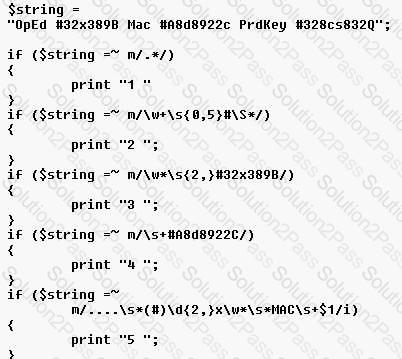1D0-437 CIW PERL FUNDAMENTALS Free Practice Exam Questions (2025 Updated)
Prepare effectively for your CIW 1D0-437 CIW PERL FUNDAMENTALS certification with our extensive collection of free, high-quality practice questions. Each question is designed to mirror the actual exam format and objectives, complete with comprehensive answers and detailed explanations. Our materials are regularly updated for 2025, ensuring you have the most current resources to build confidence and succeed on your first attempt.
Which of the following choices demonstrates the correct syntax for creating a hash?
Consider the program code in the attached exhibit. What is the result of executing this program code?

Consider the following program code:
1.$x = 100;
2.$y = "-25";
3.$sum = $x + $y;
4.
5.print $sum;
What is the result of executing this program code?
Consider the following program code:
$x = 10;
LOOP: while ($x < 15)
{
print ($x );
if ($x >= 14 && $x <= 20)
{
$x += 2;
redo LOOP;
}
else
{
$x++;
}
}
What is the result of executing this program code?
Consider the following program code:
$Animal = Dogs bark;
package Cat;
$Animal = Cats purr;
{
package Fish;
$Animal = Fish swim;
} p
ackage main;
print $Animal;
What is the result of executing this program code?
Consider that a file named test.txt contains this line of text:
One line of test text.
What is the output of the following lines of code?
$file = "test.txt";
open (OUT, "<$file") || (die "cannot open $file: $!");
seek(OUT, 15, 0);
read(OUT, $buffer, 5);
print $buffer . "\n";
print tell(OUT);
Consider the following program code:
@array = ("ALPHA", "beta", "GaMmA");
sort(@array);
print("@array");
What is the output of this code?
Which one of the following choices uses the correct syntax for a valid array assignment?
Consider the following lines of code:
sub mySub { (
$arg, @args) = @_;
foreach $val (@args) {
$returnVal .= "$arg, $val\n";
}
$returnVal . "" . @args;
}
print &mySub(1, "a value", "another value", "a parameter", "another parameter");
What is the output of these lines of code?
Consider the following program code:
@stack = (10, 10..25);
push(@stack, yellow);
shift(@stack);
push(@stack, white);
print shift(@stack);
What is the result of executing this program code?
Which statement will open the /etc/passwd file for reading only?
Which keyword indicates an object reference rather than a variable reference?
The filehandle INPUT is associated with the file represented by $file. Which statement will close the filehandle INPUT?
Consider the following program code:
@arrayA = (10, 20, 30);
@arrayB = @arrayA;
$arrayB[1] = 40;
print $arrayA[1];
What is the output of this code?
Which of the following correctly creates a SQL statement that will insert the values of the $name and $age variables into a database? The statement is assigned to the $sqlStmt variable. Assume a CHAR data type for $name and an INT data type for $age.
Which line of code represents the correct syntax to establish a reference to a database handle?
Which Perl debugger commands can be used to step through a script?
Consider the following program code:
@stack = (10, 10..25);
push(@stack, yellow);
shift(@stack);
push(@stack, white);
print shift(@stack);
What is the result of executing this program code?
Which one of the following statements uses correct syntax and expressions?
Consider the following code block:
BEGIN {print ("Jan ");}
BEGIN {print ("Feb ");}
END {print ("Mar ");}
END {print ("Apr ");}
Print ("May ");
What is the result of this code block?
